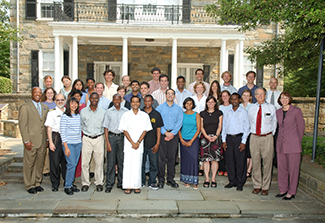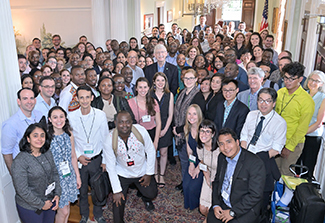Fellows & Scholars at 20: A look back
March/April 2023 | Volume 22 Number 2
 Photo: Fogarty International CenterThe inaugural cohort of 35 Global Health Fellows at orientation in 2004. At the time the program was called Fogarty-Ellison Overseas Fellowship in Global Health and Clinical Research Training.
Photo: Fogarty International CenterThe inaugural cohort of 35 Global Health Fellows at orientation in 2004. At the time the program was called Fogarty-Ellison Overseas Fellowship in Global Health and Clinical Research Training.
Fogarty's
Global Health Fellows and Scholars program has grown from its modest beginnings with only 35 scholars at 14 research institutions to supporting over 100 scholars at over 60 research institutions and sites each year. Support for the program also has grown as partners like the Ellison Medical Foundation, U.S. Department of State, and more than 25 NIH institutes, centers, and offices have partnered with Fogarty over the years—a substantial leap from the two partners who helped start the program.
Now in its 20th year, the Global Health Fellows and Scholars program has been known by many names, mirroring its evolution in priorities, demand, and opportunities for greater impact. Nevertheless, with each change, the driving force remains the same: to inspire motivated early-career health professionals and researchers worldwide to pursue a career in global health research, strengthen and expand research collaborations between the U.S. and low- and middle-income countries (LMICs), and further enhance research capacity at LMIC research institutions and sites.
In 2003, Fogarty partnered with the Ellison Medical Foundation to establish the Fogarty-Ellison Overseas Fellowship in Global Health and Clinical Research Training. The program was created to inspire students early in their professional training to consider a career in global health research by offering them first-hand exposure to challenging health issues faced by those living in LMICs and an opportunity to forge career-boosting relationships and scientific collaborations. Specifically, the program provided graduate-level U.S. students in the health sciences one year of clinical research training in an LMIC while also strengthening the research capacity in the country of study by supporting a matched or “twin" LMIC student. Fellows were placed at research institutions and sites with active NIH- and Fogarty-funded research and training programs allowing them access to accomplished U.S. and LMIC researchers who served as program mentors.
The recruitment, selection and matching of trainees were managed through a collaboration with the Association of American Medical Colleges (AAMC) and the Association of Schools of Public Health (ASPH). After submission, applications were reviewed by an AAMC review panel, followed by the Fogarty-Ellison program steering committee. Selected semi-finalists were then invited to the NIH campus to present their research proposals, learn more about the global health research funded by NIH, and interview with representatives from the LMIC institutions and sites. Final selection of the U.S. trainees depended on the rank matching of finalists and LMIC site representatives, research priorities of funders, and availability of funds. The LMIC institutions and sites underwent their own rigorous application and selection processes to match the U.S. trainees with a host-country trainee with similar research interests.
Trainee projects initially focused mainly on HIV and other infectious diseases. With additional financial support from NIH partners, the range of research topics has broadened to include areas like nephrology, heart disease, neurological disorders, mental health and cancer, to name a few. However, before being embedded into well-established research teams, the U.S. and matched LMIC trainees began their program year with an orientation at NIH. This event, a favored tradition still held every year, is an opportunity to meet the new cohort of program participants, discuss important topics in global health, and energize and inspire the trainees before beginning their “Fogarty" year.
In 2007, with the anticipated growth in size and complexity of the program, Fogarty changed its structure to become more centralized and awarded a grant to Vanderbilt University with recruitment support from AAMC and ASPH. The program also expanded to include both predoctoral students (scholars) and postdoctoral fellows. The redesigned program, renamed the Fogarty International Clinical Research Scholars and Fellows Program (FICRS-F), bridged the gap in Fogarty's global health research career pipeline between completion of graduate training and readiness to apply for career development and research grants.
Fogarty later partnered with the U.S. Department of State's Bureau of Educational and Cultural Affairs in 2010 to establish additional training opportunities for U.S. graduate students and, for a short time, postdoctorates through the Fulbright-Fogarty Fellowship in Public Health. Although managed like a traditional Fulbright fellowship, the trainees are integrated into the Fogarty-supported research training programs.
 Photo: Fogarty International CenterFellows, scholars and NIH staff pose during a reception in 2019 at the Stone House on the NIH Campus. By then, the program had grown to six consortia and was called the Fogarty Global Health Training Program.
Photo: Fogarty International CenterFellows, scholars and NIH staff pose during a reception in 2019 at the Stone House on the NIH Campus. By then, the program had grown to six consortia and was called the Fogarty Global Health Training Program.
The substantial growth of the program over the ensuing years called for another restructuring in 2012. The new Fogarty Global Health Program for Fellows and Scholars supported five consortia, each consisting of four U.S. institutions—including minority serving institutions, for most —plus LMIC research partners. Participating research training institutions and mentors came from the network of established research collaborations between faculty at the consortia's U.S. institutions and those in LMICs. Each consortium developed its own global health research training program.
The consortia in this phase of the program were VECD, led by Vanderbilt University; NPGH, led by the University of Washington; UJMT, led by the University of North Carolina; GHES, led by the University of California, Berkeley; and GloCal, led by the University of California, San Francisco. In 2017, the renamed Fogarty Global Health Training Program grew to six consortia, welcoming HBNU, led by Harvard University.
Now in its fifth cycle, the program has a name that better reflects its intentions: the Launching Future Leaders in Global Health (LAUNCH) Research Training Program. It retains the consortia structure, with a refocus on training predominately postdoctoral fellows from the U.S. and LMICs and U.S. predoctoral students. LAUNCH emphasizes broadening participation to diverse groups in the U.S. It also aims to ensure a more equitable training experience for LMIC trainees with short-term research training in the U.S. The current consortia include NPGH, UJMT, GHES, GloCal, and HBNU, with the addition of two new consortia, INSIGHT, led by the University of Maryland-Baltimore, and ACHIEVE, led by Washington University in St. Louis.
Over the last 20 years, this program has 'LAUNCHed' the careers of hundreds of global health researchers. Trainees have gone on to publish many dozens of articles in peer-reviewed journals, and many have continued their research with subsequent funding from NIH. We have highlighted the
achievements of many fellows and scholars over the years, but for every profile you read there are countless more success stories and an immeasurable impact on the field of global health research.
Updated April 6, 2023
To view Adobe PDF files,
download current, free accessible plug-ins from Adobe's website.
Related Fogarty Programs